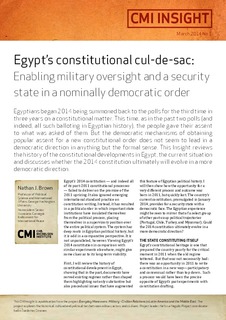| dc.contributor.author | Brown, Nathan J. | |
| dc.date.accessioned | 2018-01-04T08:18:57Z | |
| dc.date.available | 2018-01-04T08:18:57Z | |
| dc.date.issued | 2014-04-02 | |
| dc.identifier | oai:www.cmi.no:5108 | |
| dc.identifier.citation | Bergen: Chr. Michelsen Institute (CMI Insight 2014 no. 1) 7 p. | |
| dc.identifier.uri | http://hdl.handle.net/11250/2474932 | |
| dc.description.abstract | Egyptians began 2014 being summoned back to the polls for the third time in three years on a constitutional matter. This time, as in the past two polls (and indeed, all such balloting in Egyptian history), the people gave their assent to what was asked of them. But the democratic mechanisms of obtaining popular assent for a new constitutional order does not seem to lead in a democratic direction in anything but the formal sense. This Insight reviews the history of the constitutional developments in Egypt, the current situation and discusses whether the 2014 constitution ultimately will evolve in a more democratic direction. | |
| dc.language.iso | eng | |
| dc.publisher | Chr. Michelsen Institute | |
| dc.relation | CMI Insight | |
| dc.relation | 2014:1 | |
| dc.relation.ispartof | CMI Insight | |
| dc.relation.ispartofseries | CMI Insight 2014:1 | |
| dc.relation.uri | https://www.cmi.no/publications/5108-egypts-constitutional-cul-de-sac | |
| dc.title | Egypt's constitutional cul-de-sac: Enabling military oversight and a security state in a nominally democratic order | |
| dc.type | Report | |
